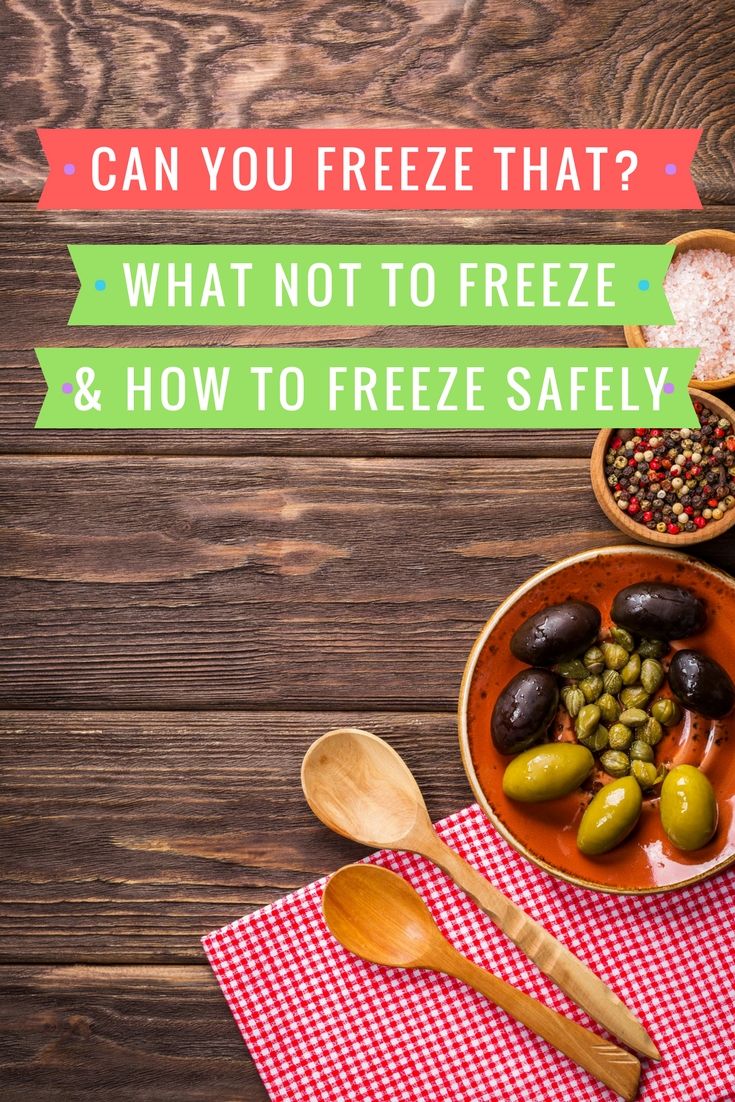It’s important to understand what freezes well and what doesn’t when embarking on a freezer cooking plan. Keep in mind when you choose meals to freeze, that freezing changes the texture of some foods. For instance high moisture fresh foods don’t really freeze well if you plan to eat them in raw form later. For instance, you can’t freeze a raw chef salad and expect it to taste like a fresh chef salad after freezing. But you can freeze chopped tomatoes to use in a sauce later.

Don’t Freeze These Foods:
- Apples
- Basil
- Celery
- Chives
- Cottage Cheese
- Cream Cheese
- Crumb Toppings
- Cucumbers
- Custard
- Eggs in the Shells
- Frosting
- Grapefruit
- Lemons
- Lettuce
- Limes
- Mayonnaise
- Oranges
- Parsley
- Radishes
- Salad Dressing
- Salad Greens
- Sauces
- Sour Cream
- Sprouts
- Watermelon
- Yogurt
Freeze with Caution:
Cheese — You can actually freeze cheese as long as you understand the texture will change. It will be crumbly, (shred it first) and you can’t eat it as is, but you can use it in a casserole as a topping. So, if you put cheese on top of a casserole that you’re going to pop into the oven to reheat anyway it’s fine. But if you plan to slice it for a sandwich, you probably don’t want to freeze your cheese.
Fried Food — You can freeze fried food as long as you wrap it right, and then reheat it correctly. For something like fried chicken be sure to cool it down while draining off the extra fat, then wrap with freezer paper and then put it inside an air tight container. To reheat, put in the oven frozen after unwrapping on a greased pan.
Grapes — Everyone knows you can freeze grapes if you plan to eat them frozen. A nice treat and tastes like dessert.
Onions & Peppers — You can chop these and freeze them to use in recipes. Chop and let them dry on a paper towel first to drain off extra moisture. Spread them on a cookie sheet and freeze for about an hour before putting them into airtight freezer bags.
Tomatoes — You can chop them and freeze into serving sizes or recipe sizes in airtight containers. You can only use them for sauces after freezing or in a soup or stew where texture isn’t as important.
Oranges & Citrus — You cannot freeze the fruit but you can freeze the zest. Zest onto a paper towel, and let dry out a bit, then freeze in one layer on a pan for about an hour. Pour into a airtight container to use in recipes.
Rice & Potatoes — They freeze fine in casseroles and dishes, but it does change their texture a bit. You cannot freeze them raw; you must precook and then freeze.
Pasta – While many places have pasta on the ‘no freeze’ list, you can freeze cooked or frozen pasta. It is recommended that you freeze pasta for some dishes uncooked because it will cook during the reheating and you don’t want to overcook it. But, you need to use prepared dried pasta and not freshly made pasta that isn’t dried.
The important thing is to remember to prepare the dishes correctly for storage and to reheat them properly. You have to be sure that your freezer is the right temperature, (under 0°F) and in good repair and that you consider the moisture content of anything that you plan to freeze. Moisture expands when it freezes.
Looking for more posts like this? Check these out:

I really want to freeze an egg, JUST TO SEE what happens! LOL!
hard boiled eggs explode in the microwave… maybe they implode in the freezer? lol!